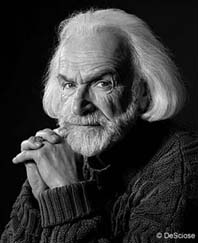Karl H. Pribram, MD

From his wiki page...
Karl H. Pribram (born February 25, 1919 in Vienna, Austria) is a professor at Georgetown University, and an emeritus professor of psychology and psychiatry at Stanford University and Radford University. Board-certified as a neurosurgeon, Pribram did pioneering work on the definition of the limbic system, the relationship of the frontal cortex to the limbic system, the sensory-specific "association" cortex of the parietal and temporal lobes, and the classical motor cortex of the human brain. To the general public, Pribram is best known for his development of the holonimic brain model of cognitive function and his contribution to ongoing neurological research into memory, emotion, motivation and consciousness. Amercian best-selling author Katherine Neville is his significant other.
Pribram's holonomic model of brain processing states that, in addition to the circuitry accomplished by the large fiber tracts in the brain, processing also occurs in webs of fine fiber branches (for instance, dendrites) that form webs. This type of processing is properly described by Gabor quanta of information, wavelets that are used in quantum holography, the basis of fMRI, PET scans and other image processing procedures.
Gabor wavelets are windowed Fourier transforms that convert complex spatial (and temporal) patterns into component waves whose amplitudes at their intersections become reinforced or diminished. Fourier processes are the basis of holography. Holograms can correlate and store a huge amount of information - and have the advantage that the inverse transform returns the results of correlation into the spatial and temporal patterns that guide us in navigating our universe.
David Bohm had suggested that were we to view the cosmos without the lenses that outfit our telescopes, the universe would appear to us as a hologram. Pribram extended this insight by noting that were we deprived of the lenses of our eyes and the lens like processes of our other sensory receptors, we would be immersed in holographic experiences.
Listen to Karl's on "Soma Time"
Here's some highlight clips
Here's some highlight clips
Clip 1: Sensory Cortex For Action
Clip 2: The 40 Hertz Debate
Clip 3: Interdigitation! Here's some highlight clips
Click here to read the abstract of Karl's 2009 paper "Minding Quanta And Cosmology"
Click the picture to visit Karl's 'scholarpedia' page

Click Below To Discuss Karl's work on our Message Board
2010 CoCo Message Board